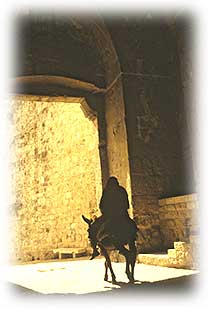Growing up, my church didn’t celebrate Lent. But years ago I caught the vision from a friend and I’ve come to value it. Here are four ways Lent can deepen our life with Christ and enrich our celebration of Easter.
Except for my Catholic neighbor getting her forehead smudged on Ash Wednesdays, Lent wasn’t even on my radar. We didn’t celebrate Palm Sunday. Or Good Friday. Much less 40 days of fasting, sacrifice and repentance. But I’ve learned we have so much to gain from observing Lent.
If your church doesn’t observe it, you can embrace it in your own way, just as the church developed its own way over the years, stretching its observance from two to three days to three weeks to 40 days. It doesn’t matter how long we engage with it, the important thing is that, in honor of his inestimable sacrifice for us, we embrace a season of sacrifice of our own for the Lord Jesus.
• Observing Lent slows us down enough to reflect
So many times we are jet-skiing along the surface of life. Lent invites us to park it. Take some time to dive deep. Talk to God and your soul. Like the Psalmist, ask yourself, “Oh my soul, why are you feeling downcast?” Or bored. Or uninspired? Or distracted? How do I get refocused on the Lord Jesus? On loving him more? On the fellowship of his suffering sacrifice for me? On becoming the person he sacrificed for me to become, the person I long to be?
Lent is not simply a surfacy “giving up something you like.” As Ruth Haley Barton says, “The real question of the Lenten season is how will I clear out the junk and garbage in my life so that I can be restored to God in some fresh way? What are the disciplines that will open up space for God to create a clean heart and new spirit in me?”
Ask yourself…how am I getting distracted? Do you want to spend more face time with the Lord Jesus? What is getting in your way? Sleeping late? Too much time in front of your screens?
What is keeping us from loving others well? Maybe we spend less time on X so I can add something, rather than subtract it…make a phone call or two a day to people who need my touch. Who needs encouragement? How can we be Jesus with skin on for another?
• Giving up prepares us for the joy of receiving
The discipline of sacrifice, of forgoing a favorite past time or returning something we bought, or not eating what we want clarifies and strengthens. Yielding up our own agenda clears away distraction. Focuses our attention on the road of Jesus’ sacrifice to the cross.
I think of the self denial of Lent like the sherbet served in a fine restaurant before the next course. It cleanses the palate and prepares mind, heart and body to experience more keenly the journey ahead.
• Personally entering into the Larger Story makes Easter a more vivid, meaningful experience
With the rise of the Protestant Church, and even more so in modern times, many churches abandoned rituals and liturgy that felt meaningless. Many believers wanted to recover and focus on the teaching of God’s Word. Understanding. Clarity. Certainty. The way of entering into the Larger Story through the Church calendar was devalued and, for many, almost lost.
Except for abbreviated celebrations of Christmas and Easter, it was no longer the season of Advent or Lent. For many contemporary churches the spotlight is only on resurrection. Easter! Not suffering, sacrifice or crucifixion.
 For the last thirteen years here’s how I’m recovering the Story: I prayerfully read the story in the gospels throughout Lent, especially during the final week of the Passion. I begin with Palm Sunday and The Triumphal Entry. I read those passages in each gospel and meditate on what it must have been like to be with Jesus as he set his face like a flint toward Jerusalem.
For the last thirteen years here’s how I’m recovering the Story: I prayerfully read the story in the gospels throughout Lent, especially during the final week of the Passion. I begin with Palm Sunday and The Triumphal Entry. I read those passages in each gospel and meditate on what it must have been like to be with Jesus as he set his face like a flint toward Jerusalem.
Most years I’ve also read from a Lenten reader.
I also open Immanuel, God with Us, Robert Doares magnificent drawings of the life of Christ, and set it on my sofa table, turning the pages each day. (It’s an expensive book, but you can find used copies on Amazon for under $10)
As I’ve engaged with the story through the Bible and art, the drama of this Story has become much more meaningful. The conflict between Jesus and the religious leaders ratchets up. Jesus forces a showdown by driving his donkey straight into Jerusalem. Fulfilling prophecy. Accepting worship. Provoking the Sanhedrin to desperation. Our place! Our power! Our tradition!
They conspire to murder. Jesus wants out. In Doares’ portrayal, Jesus in Gethsemene, not kneeling with a halo, but prostrate in the dirt. Face to the side. Arms extended. Hands open. Pleading. I have never come close to praying like that over God’s will. For the love of the Father. For the love of outsiders. I think more deeply about Jesus’ love for us. We have no idea.
The conflict reaches a climax with the crucifixion. So the religious leaders think. The real climax of the story is the Resurrection two days later. What a terrific plot reversal and surprise ending of this act.
Entering into the story through Scripture, prayer and art makes it real. It reminds me that I am a character in this story and I have a strategic role to play downline.
• Lent helps us feel more intensely the sorrow and joy of Easter
As I read the story and study Doares’ powerful images I feel the growing tension. I mourn Jesus suffering. I rejoice in Jesus’ triumph over death. In fact, my joy on Easter Sunday is so much more vivid because I’ve deeply processed Jesus’ suffering and death.
Some make a case for not dwelling so much on Jesus suffering and death. After all, we live on this side of the resurrection. We should focus on and celebrate the victory.
 But who goes to a movie or reads a novel and skips over the darkest hour before the dawn? If we skip over Han Solo frozen in a cryo-prison or the Fellowship of the Ring breaking apart…if we just skip to the big Ewok party at the end or the crowning of the King then we have missed the real impact of the story. We’ve drastically short changed our experience of the depth of the lows which make the height of the highs more joyful by contrast.
But who goes to a movie or reads a novel and skips over the darkest hour before the dawn? If we skip over Han Solo frozen in a cryo-prison or the Fellowship of the Ring breaking apart…if we just skip to the big Ewok party at the end or the crowning of the King then we have missed the real impact of the story. We’ve drastically short changed our experience of the depth of the lows which make the height of the highs more joyful by contrast.
The apostle Paul earnestly desired, “that I may know him (Jesus) and the power of his resurrection, and may share his sufferings, becoming like him in his death…” Surely one way to share Christ’s sufferings is to deeply enter into the story of his suffering so that we might grasp a little more the depths of his sorrow and anguish and love for us. This then becomes a deeper source of strength and comfort as we enter our own trials and can trust that he understands. He empathizes. Are we betrayed and abandoned? So was he.
God has written the most wrenching, soaring drama conceivable. But we get so used to it. Throughout Lent the richness of “Jesus Saves” flows into my life. And again I am overwhelmed by the love of Christ. Thank you, Lord Jesus, my king and my God.
If you you have discovered some ways to make the experience of Easter more meaningful to you, what are they? Please respond in the comment section below…


“Who needs encouragement? How can we be Jesus with skin on for another”
I don’t agree. Look at that http://www.thoroughlyalive.com/2015/02/
Hi Margarita, Thanks for taking the time to comment. And thanks for introducing me to Sarah at Thoroughly Alive. I really enjoyed her post. However, even after I read it I’m still not sure what you disagree with…care to elaborate?